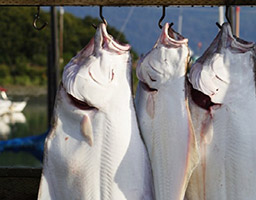
ARC
AS
Fish
export and marketing from Norway
http://fish.a-11.com E-Mail : fish@a-11.com
 |
ARC
AS Fish
export and marketing from Norway |
Norway Time |
Farmed fish |
Contact |
| Farmed fish include: Salmon, Trout Cod and Halibut. The advantages of farmed fish compared with wild fish are: availability, fast growth, controlled nutrition, fish quality, hygiene (free of potential parasite and pollutants). Cultivated fish are bred in 3 farm classes: |
Atlantic
Salmon
Fish farming Size: Nutritional content Fresh salmon |
|
 |
 |
 |
 |
 |
 |
 |
 |
Rainbow
Trout Season: Use Nutritional content Nutritional
content table. Fresh trout |
|
 |
 |
 |
 |
 |
 |
Norwegian
Arctic char Season: Nutritional content Fresh and frozen Arctic Char |
| Farmed
Cod Latin - Gadus morhuas Norsk - Torsk Deutsch - Kabeljau / Dorsch Français - Morue de l'Atlantique / Cabillaud Nederlands - Kabeljauw Italiano - Merluzzo / Baccalà Español - Bacalao Português - Skrei / Bacalhau |
|
 |
 |
Farming of cod is gradually increasing in Norway. The global over- exploitation of the wild cod fishery has led to a sharp increase in the market value of cod, leading to a great interest in the farming of this species. The farming process and on-growing stage of the cod is very similar to that of farmed salmon, so much of the equipment needed for this industry is already in place from the established farming of salmon. The market size for farmed cod is the same as for wild fish, being between 2-5 kg. This would require an on-growing phase of 18-28 months depending on fish size. Farmed cod experience high growth rates, which results in the fact that they mature earlier than wild fish. The advantages of farmed cod are many, such as year-round supply, full traceability and freshness and no risk of anisakis- parasites. Use Nutritional content |
|
Norwegian
farmed white halibut Nutritional content |
|
 |
 |